
Anthracotherium is an extinct genus of artiodactyls characterized by having 44 teeth, with five semi-crescentic cusps on the crowns of the upper molars. The genus ranged from the middle Eocene period until the early Miocene, having a distribution throughout Eurasia. Material subjectively assigned to Anthracotherium from Pakistan suggests the last species died out soon after the start of the Miocene.

Elomeryx is an extinct genus of artiodactyl ungulate, and is among the earliest known anthracotheres. The genus was extremely widespread, first being found in Asia in the middle Eocene, in Europe during the latest Eocene, and having spread to North America by the early Oligocene. The closest living relatives of the Elomeryx are bovids, suids, and cetaceans.
Hsanotherium is an extinct genus of early ungulate from the middle Eocene, described in 2000 in the Pondaung Formation, Myanmar.
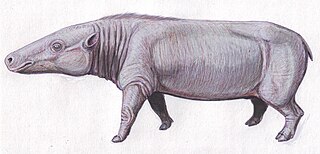
Anthracotheriidae is a paraphyletic family of extinct, hippopotamus-like artiodactyl ungulates related to hippopotamuses and whales. The oldest genus, Elomeryx, first appeared during the middle Eocene in Asia. They thrived in Africa and Eurasia, with a few species ultimately entering North America during the Oligocene. They died out in Europe and Africa during the Miocene, possibly due to a combination of climatic changes and competition with other artiodactyls, including pigs and true hippopotamuses. The youngest genus, Merycopotamus, died out in Asia during the late Pliocene, possibly for the same reasons. The family is named after the first genus discovered, Anthracotherium, which means "coal beast", as the first fossils of it were found in Paleogene-aged coal beds in France. Fossil remains of the anthracothere genus were discovered by the Harvard University and Geological Survey of Pakistan joint research project (Y-GSP) in the well-dated middle and late Miocene deposits of the Pothohar Plateau in northern Pakistan.
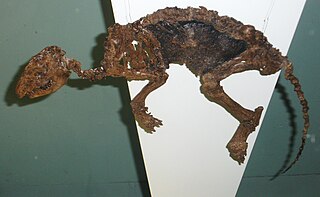
Dichobunidae is an extinct family of basal artiodactyl mammals from the early Eocene to late Oligocene of North America, Europe, and Asia. The Dichobunidae include some of the earliest known artiodactyls, such as Diacodexis.
Anthracothema was a genus of extinct artiodactyl ungulate mammals that lived in Myanmar during the late Eocene.

Anthracokeryx is a genus of extinct artiodactyl ungulate mammal belonging to Anthracotheriidae that lived in Asia during the middle to late Eocene.
Brachyhyops is an extinct genus of entelodont artiodactyl mammal that lived during the Eocene Epoch of western North America and southeastern Asia. The first fossil remains of Brachyhyops are recorded from the late Eocene deposits of Beaver Divide in central Wyoming and discovered by paleontology crews from the Carnegie Museum of Natural History during the early 20th century. The type species, Brachyhyops wyomingensis, is based on a single skull and was named by E.H. Colbert in 1937, but was not officially described until 1938. During the latter half of the 20th century, additional specimens from North America have been recorded from Saskatchewan and as far south as Texas, indicating that Brachyhyops had a broad distribution and was well-dispersed throughout western North America.
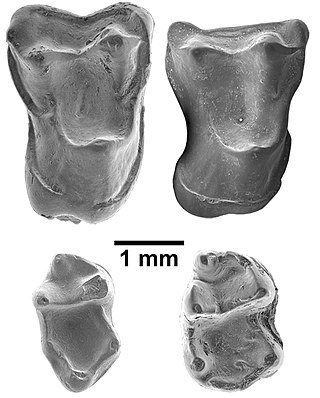
Afrasia djijidae is a fossil primate that lived in Myanmar approximately 37 million years ago, during the late middle Eocene. The only species in the genus Afrasia, it was a small primate, estimated to weigh around 100 grams (3.5 oz). Despite the significant geographic distance between them, Afrasia is thought to be closely related to Afrotarsius, an enigmatic fossil found in Libya and Egypt that dates to 38–39 million years ago. If this relationship is correct, it suggests that early simians dispersed from Asia to Africa during the middle Eocene and would add further support to the hypothesis that the first simians evolved in Asia, not Africa. Neither Afrasia nor Afrotarsius, which together form the family Afrotarsiidae, is considered ancestral to living simians, but they are part of a side branch or stem group known as eosimiiforms. Because they did not give rise to the stem simians that are known from the same deposits in Africa, early Asian simians are thought to have dispersed from Asia to Africa more than once prior to the late middle Eocene. Such dispersals from Asia to Africa also were seen around the same time in other mammalian groups, including hystricognathous rodents and anthracotheres.
Indolophus is an extinct genus of perissodactyl belonging to the clade Tapiromorpha, which includes modern-day tapirs. Fossils have been found in the Early Eocene of Myanmar.
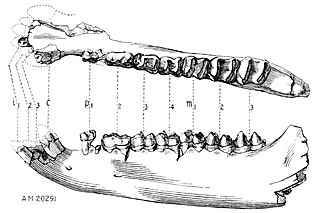
Deperetella is an extinct genus of deperetellid perissodactyls from Middle to Late Eocene of Asia. The genus was defined in 1925 by W. D. Matthew and Walter W. Granger, who named it after French paleontologist Charles Depéret. The type species is Deperetella cristata.
The Amphipithecidae were simian primates that lived in Late Eocene and Early Oligocene. Fossils have been found in Myanmar, Thailand, and Pakistan. The limited fossil evidence is consistent with, but not exclusive to, arboreal quadrupedalism. In other words, the species may have moved about in trees on four legs, but not with regular leaping as seen in later simians.
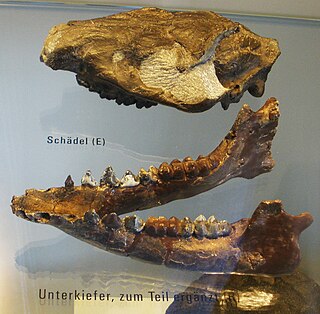
Microbunodon was a genus of extinct artiodactyl mammals in the family Anthracotheriidae. It lived between the upper Eocene and the lower Pliocene. Its fossil remains have been found in Europe and Asia.

Helohyidae were a group of artiodactyl mammals. They were most prominent in the mid-to-upper Eocene.

The bothriodontines are a paraphyletic assemblage of anthracotheres that originated from Eurasia in the late middle Eocene (Bartonian). The group can be distinguished from other anthracothere lineages by their upper molars having a mesostyle occupied by a transverse valley, selenodont cusps, a ventrally concave symphysis, elongated muzzles, and a diastema between the canine and first premolar tooth. During their evolution, the bothriodontines evolved from small basal forms such as Qatraniodon into larger taxa such as Libycosaurus and Merycopotamus. In some genera, the snouts became even more elongated and teeth specialized in a folivorous diet, while others like Merycopotamus developed wide, heavy, and shallow muzzles with teeth more adapted for grazing.

The microbunodontines were an extinct subfamily of anthracotheres that were predominately a Paleogene group of Eurasian artiodactyls. The group died out at the end of the Late Miocene. It comprised the genera Anthracokeryx, Geniokeryx, Microbunodon, and possibly Etruscotherium. They are different from the other anthracothere lineages by their smaller size, slenderer limbs and male specimens having laterally compressed, longer canines. They were originally classified as members of the other subfamily of anthracotheres, Anthracotheriinae but recent phylogenetic studies have found them to be their own clade which is sister to Bothriodontinae.

The anthracotheriines are an extinct subfamily of anthracotheres that comprised Paleogene to early Neogene North American and Eurasian artiodactyls. The group contained the genera Anthracotherium, Heptacodon, and Paenanthracotherium, as well as possibly Myaingtherium and Siamotherium. They were small to large sized anthracotheres, and when compared to the other two subfamilies, Microbunodontinae and Bothriodontinae, anthracotheriines are found to occupy a primitive, basal position in the family.

Ancodonta is an infraorder of artiodactyl ungulates including modern hippopotamus and all mammals closer to hippos than to cetaceans (whales). Ancodonts first appeared in the Middle Eocene, with some of the earliest representatives found in fossil deposits in Southeast Asia. Throughout their evolutionary history they have occupied different browsing and grazing niches in North America, Eurasia and Africa. The last continent is notable as they were among the first laurasiatherian mammals to have migrated to Africa from Europe, where they competed with the native afrothere herbivores for the same niches. Of the nearly 50 genera that have existed, only two of them are extant – Choeropsis and Hippopotamus. The interrelationships within the ancodonts has been contended. The traditional notion is that there at minimum two families Anthracotheriidae and Hippopotamidae and were merely sister taxa. However many detailed research of the dentition among ancodonts, as well as how some anthracotheres were similar to hippos in appearance, lead the current consensus where Anthracotheriidae is paraphyletic to Hippopotamidae. Among the anthracotheres, members of Bothriodontinae are among the closest to the ancestry of hippos, with the Oligocene aged Epirigenys from Lokon, Turkana, Kenya being the sister taxon to hippos. In response of this many similar clade names have been used for this clade.
Heptacodon is an extinct genus of anthracothere endemic to North America during the Paleogene. They were medium to large-sized anthracotheres with distinct facial features, such as short heavy rostrums and robust but simple molars. Heptacodon is a member of the anthracothere subfamily Anthracotheriinae, whose distribution as a whole included North America and Eurasia. However Heptacodon has only been found in North America, with the species H. yeguaensis from Texas representing the oldest known anthracotheres to be found in North America dating to the middle Eocene. Fossils of this genus have been found in the states of North Dakota, Oregon, South Dakota, Texas, and Utah.
The Ergilin Dzo Formation, is a geologic formation in southeastern Mongolia. It preserves fossils of a wide variety of animals, which date back to the late Eocene epoch. The type fauna of the Ergilian Asian land mammal age is defined by the mammalian fossils of this formation.











